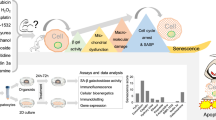Summary
The existence, origin, and bipotency of the hepatic stem cell (HeSC) have been investigated. However, the isolation and culture of HeSCs from adult liver tissue is not yet well established, and the mechanism by which HeSCs differentiate into mature cells remains unclear. On the other hand, the development of HeSC-isolating and-culturing methods and the in vitro clonal analysis of their mechanism of differentiation are required to enable clinical applications of regenerative medicine in the liver. For the purpose of providing HeSCs for these studies, we attempted to establish an HeSC line from a normal adult porcine liver using a unique culture system, a poly-D-lysine-coated culture dish with NAIR-1 medium (the PDL-NAIR-1 culture system). Moreover, we examined the differentiating capacity of HeSCs in vitro. We demonstrated that it was possible in the culture system that immature epithelial cells capable of proliferating grew selectively into aggregates and that two hepatic stem-like cell lines, PHeSC-A1 and PHeSC-A2, were established. The results from our data suggest that these hepatic stem-like cell lines were capable of self-renewing and differentiating into hepatocytes or biliary epithelial cells and show that the PDL-NAIR-1 culture system offers the immense advantage of isolating and culturing HeSCs from a normal adult liver. Furthermore, because of the ability to use a clonal analysis in vitro, these cell lines are useful for the investigation of various mechanisms in which HeSCs seem to participate and their application in the study of regenerative medicine in the liver.
Similar content being viewed by others
References
Alison M. R.; Poulsom R.; Jeffery R., et al. Hepatocytes from non-hepatic adult stem cells. Nature 406:257; 2000.
Fausto N. Liver stem cell. In: Arias I. M.; Boyer J. E.; Fausto, N.; Jakaby W. B.; Schachter D. A.; Shafritz D. A., ed. The liver: biology and pathbiology, 3rd ed. New York; Raven Press; 1994;1501–1518.
Gibson U. E.; Heid, C. A.; Williams, P. M. A novel method for real time quantitative RT-PCR. Genome Res. 6:995–1001; 1996.
Grisham, J. W.; Thorgeirssoh S. S., Liver stem cells. In: Potted, C. S., ed. Stem cells, chap. 8, London: Academic Press; 1997:233–282.
Gustavsson, I. Standard karyotype of the domestic pig. Committee for the standardized karyotype of the domestic pig. Hereditas 109:151–157; 1988.
Kano J.; Noguchi, M.; Kodama, M.; Tokiwa T. The in vitro differentiating capacity of nonparenchymal epithelial cells derived from adult porcine livers. Am. J. Pathol. 156:2033–2043; 2000.
Kano, J.; Tokiwa, T.; Zhou, X.; Kodama, M. Colonial growth and differentiation of epithelial cells derived from abattoir adult porcine livers. J. Gastroenterol. Hepatol. 13:62S-69S; 1998.
Lagasse, E.; Connors, H.; AL-Dhalimy, M., et al. Purified hematopoietic stem cells can differentiate into hepatocytes in vivo. Nat. Med. 6: 1229–1234; 2000.
Lazaro, C. A.; Rhim, J. A.; Yamada, Y.; Fausto, N. Generation of hepatocytes from oval cell precursors in culture. Cancer Res. 58:5514–5522; 1998.
Petersen, B. E.; Bowen, W. C.; Patrene, K. D. et al. Bone marrow as a potential source of hepatic oval cells. Science, 284:1168–1170; 1999.
Petit-Zeman, S. Regenerative medicine. Nat. Biotechnol. 19:201–206; 2001.
Theise, N. D.; Badve, S.; Saxana, R.; Henegariu, O.; Sell, S.; Crawford, J. M. Krause, D. S. Derivation of hepatocytes from bone marrow cells in mice after radiation-induced myeloablation. Hepatology 31:235–240; 2000a.
Theise, N. D.; Nimmakayalu, M.; Gardner, R. et al. Liver from bone marrow in human. Hepatology 32:11–16; 2000b.
Theise, N. D.; Saxena, R.; Portmann, B. C., et al. The canals of hering and hepatic stem cells in humans. Hepatology 30:1425–1433; 1999.
Tokiwa, T.; Yamazaki, T.; Kano, J.; Noguchi, M.; Enosawa, S.; Kohno, M. Colony-forming capacity of porcine liver epithelial cells in culture. In Vitro Cell. Dev. Biol. 38A:440–442; 2002.
Yin, L.; Sun, M.; Ilic, Z.; Leffert, H. L.; Sell, S. Derivation, characterization, and phenotypic variation of hepatic progenitor cell lines isolated from adult rats. Hepatology 35:315–324; 2002.
Author information
Authors and Affiliations
Corresponding author
Rights and permissions
About this article
Cite this article
Kano, J., Ishiyama, T., Nakamura, N. et al. Establishment of hepatic stem-like cell lines from normal adult porcine liver in a poly-D-lysine-coated dish with nair-1 medium. In Vitro Cell.Dev.Biol.-Animal 39, 440–448 (2003). https://doi.org/10.1290/1543-706X(2003)039<0440:EOHSCL>2.0.CO;2
Received:
Accepted:
Issue Date:
DOI: https://doi.org/10.1290/1543-706X(2003)039<0440:EOHSCL>2.0.CO;2




